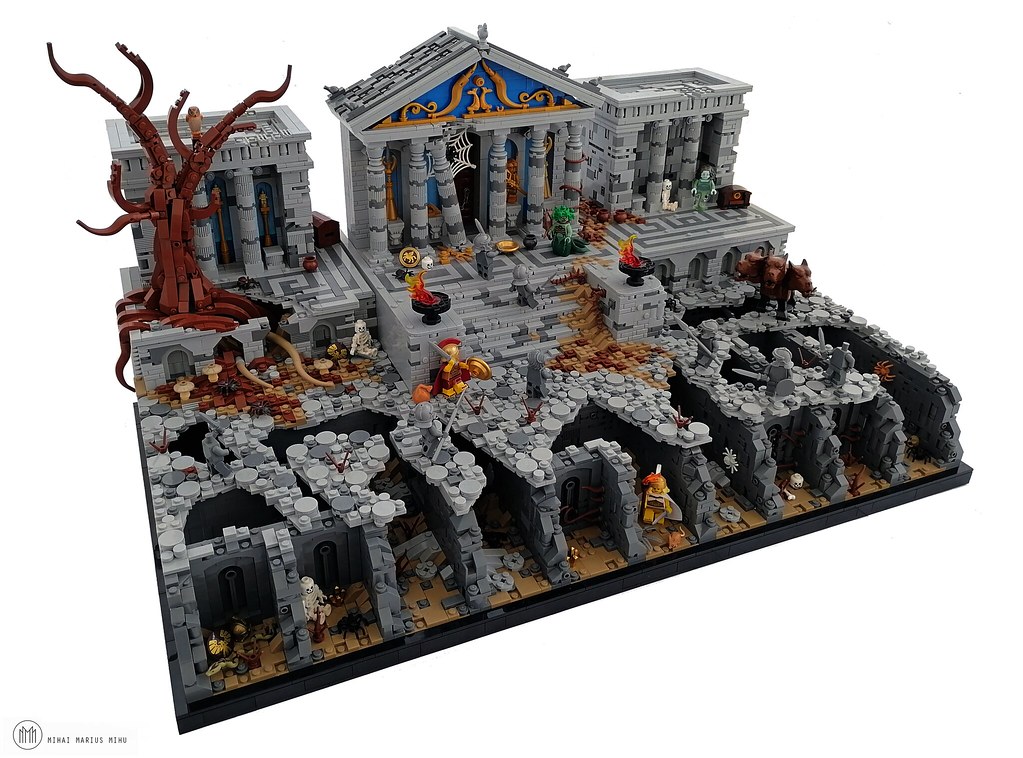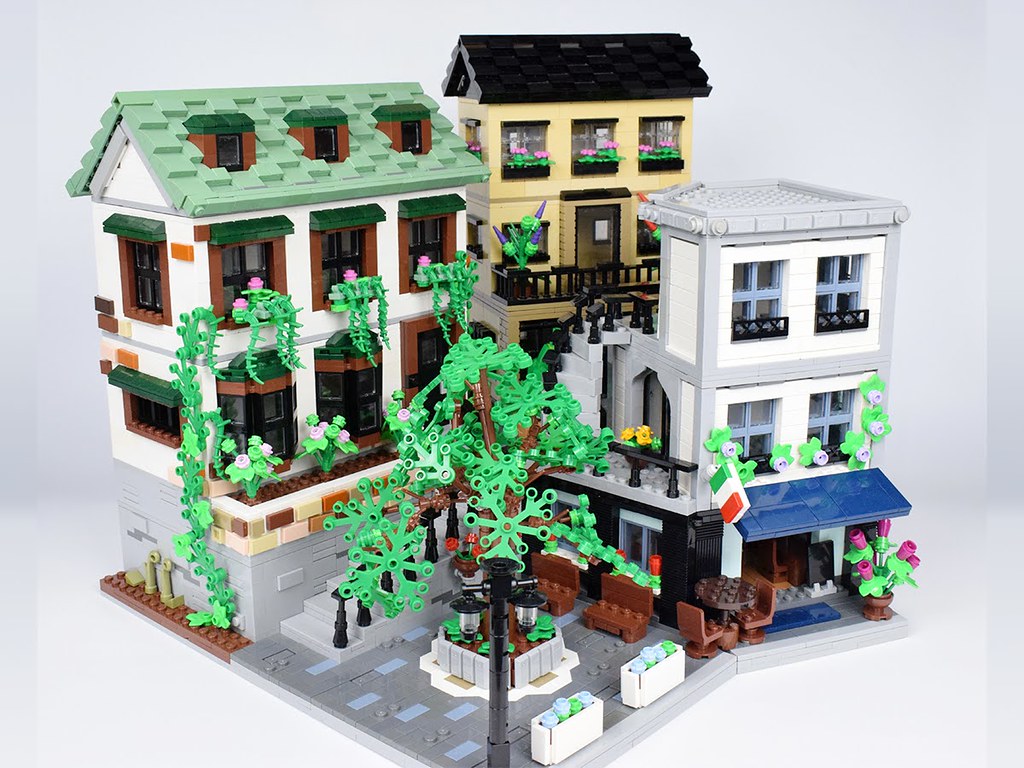One of my all-time favorite games doesn’t have a name but its variations are known by many. The “telephone” game, in its many forms, gravitates around the idea of altering a phrase, image, or item slightly as it’s passed around to each participant. While most of us played it as kids, some adult fans of LEGO like to play a version of their own that is often out of this world. Builder Eli Willsea created the STG-2 Sailer as the 4th iteration in the latest telephone series. The small, rockhopper-style craft somewhat reminds me of the starter ship in No Man’s Sky (NMS) with its compact body and raised back portion. More NMS parallels arise with the solar sail sections with boosters firing off behind them. The sails creatively use the balloon sections from Friends sets and Sweet Mayhem’s Systar Starship along with some golden rigging for deployment and retraction. The coloration and parts usage give this ship lots of curves and angles that really catch the eye, an essential part of good spaceship building. Greeble, or detail, all you want but if your ship doesn’t visually swoop it’ll probably end up resembling a flying, mechanical potato. Thankfully, Eli knows how to avoid the spud fate and instead made a fantastic little puddle jumper that the next builder will have fun emulating.
Posts by Chris Burden
Floating up to the city in the sky
Far from Norman Greenbaum’s lyrics but still suiting the rhythm, this futuristic flying city by Builder Umbra-Manis certainly looks like a paradise all its own. A microscale aircraft sits on one side of the city’s extended air-docks, leading into a thick, walled courtyard. Trees exposed to the open air line the exterior of the platforms, using brown claws with green flower studs attached to the versatile, hexagonal NEXO Knights plates which make up the structure’s base. Nice parts usage certainly abounds in this model. Minifigure rollerskates with trans-yellow tombstone plates, as I call them, make great little courier vessels which enter the city and circle its interior. The sculpting and coloration of the buildings make me feel like I’m playing a LEGO version of a Ratchet and Clank level which is nothing to complaing about.
Too deep to see
As the summer weather begins to truly set in, opportunity opens up for expeditions in calming seas. Builder BetaNotus was inspired by nature to create this deep submersible vehicle (DSV) using a wealth of Technic panels and detailed arm sections. The shaping of the large panel pieces have a wonderful flow that reads perfectly as the solid exterior of most DSV since battling the high pressure of the ocean depths requires a thick hull. The grill section on top is a great element for this style of craft and the yellow panels are nice additions to break up the monotonous white. Of course, once you’re down there, you’ll want to be able to see. Large lamps above and below the bulbous clear pilot section illuminate the surroundings, startling any creatures that might be floating in the dark.
With those claw arms, its super easy for the craft to interact with its environment. Sure, it might be a little jarring for the clam, but at least we get to discover the secrets of the deep. Come to think of it, this would be a great partner build with the Titanic set. Then you could fully recreate James Cameron’s classic. Maybe BetaNotus was thinking about this on some level.
Statues above, catacombs below
If you’re going to build a massive scene for your stars, you’ve got to make sure there are plenty of supporting actors. The side stories that builder Mihai Marius Mihu includes in this work called Medusa’s Lair elevate this from a detailed scene to a multileveled story. The stars of the scene are debatably dependent on elevation but the above-ground scene is the most fleshed out. Maybe “fleshed out” is the wrong turn of phrase for such a stone-filled scene. The carved columns and painted reliefs remain unpilfered, tying in the historical art and architecture to match the thematic characters. A presumable Perseus perches himself at the base of the steps as Medusa makes her way across the patterned precipice. Old foes stand as stone statues while their treasures and trinkets fall to the side to remain untouched. Those that found themselves trapped in their hiding spots now sit as bones, victims of the deadly wildlife or their own hunger.
Street corner coffee shop
There’s nothing better than a relaxing stroll through the alleys and streets of a quaint LEGO village, this one constructed by Y. Muto. Multiple levels of terraces attach to the different buildings perched above the tight courtyard below. Delightful roofing techniques in different colors give the different rooftops their own individual character. Each building’s window treatments seem to provide a place for window gardens or ivy. I especially love the different color tiles contrasting the white walls of the green-roofed building with the bay windows.
Check out what else is brewing in this build!
A proper TRON cycle
Veteran builder Simon Liu made the most of an opportunity during his latest review for New Elementary. Given the chance to pick the set he wanted to write about, he jumped on the smorgasbord of glow-in-the-dark pieces available in June 2021’s LEGO Monkie Kid 80028 The Bone Demon. Making use of the angles and curves presented by parts selection in the set, Simon was able to finally execute a proper glow-in-the-dark TRON cycle. As a bit of a dream for Simon, he was excited to pull it off, no matter what the scale. Of course, that meant that things got a little more difficult once he got attached to that swoop of White Glow curve in the center of the bike. Sandwiching the two sides together at a scale he liked only left a tile’s thickness for the core of the body. The wheels were almost too easy, the clever curve using rounded 1×2 plates centered with that tile’s thickness to provide an attachment point for the glowing rims made with 3×3 1/4 arch bricks. Black detailing on the body is complemented by 45-degree cut slopes near the base and handlebars, completing that quintessentially TRON light cycle feel.
Just one of a few great builds that Simon worked on for New Elementary, this TRON cycle entices the building community to see what else they can do with a fist full of glow-in-the-dark elements. Clearly, there’s potential for tech and sci-fi models so who knows what use Simon will find for these highly UV-reactive pieces this year. It could make for one interesting SHIPtember if he was feeling adventurous.
Microscale Waterfall Temple
Microscale LEGO builds can either be the most beautiful or the wonkiest creations out there. Builder Gilles de Crombrugghe pulled all the stops when it came to creating this gorgeous jungle temple scene, from nice piece usage to clever techniques. The choices he made helped create an engrossing, detailed, and realistic scene that feels like an Indiana Jones version of Polly Pocket. Opposing orientations for bricks help create the smooth blue outline of the pool of water. Headlight bricks in the base help attach the waterfalls which cascade serenely to clouds of mist made of ice cream and popcorn pieces. Brown Technic chainlinks make for a wonderful rope bridge with plenty of rickety slack. Steep, stony islands of meticulously sculpted slopes and modified tiles rise from the water, isolating the long-forgotten sacred grounds. At least, until the research team found their way there.
A charmed LEGO cottage
A quaint little stone cabin in the woods is overgrown with vines and flowers. Far from a creepy, stereotypical witch’s home, this project by builder Castor Troy, in collaboration with builder Max Brich, was focused on giving witches a better image. The creatures of the forest seem to love gathering around this witch’s delightful cottage. The builders sought after a more rehabilitated, benevolent witch, emphasizing the magical relationship with nature and their healing abilities, instead of reinforcing negative stereotypes. Wooden accents define the edges of the stonework wall using brown hinges and a little bit of LEGO geometry. Angled roofs snugly cover the home, as a cobbled chimney rises up next to a lovely A-frame roof as tall as the tree next door.
Click here to continue reading.
The two-horsepower Pig house
Internationally recognized director and creator Hayao Miyazaki has had an inspirational effect the world over through his work at Studio Ghibli. Builder Andrea Lattanzio has been open about how Miyazaki’s films and stories have influenced his own models in the past. His latest model is a tribute to the home Miyazaki had built near Studio Ghibli’s main building back in 1998. Framed by brightly colored trees that contrast the grey and black tilework covering the building, Andrea shows off his architectural skills in yet another masterful model. Offset tiles help create an effect similar to the original wooden siding while fresh planks and posts in the deck, yet to become green with moss, provide a peaceful place for the famed director to contemplate life.
One stellar ship on patrol
The latest custom spaceship by Builder Caleb Ricks is a blend between classic shuttles and futuristic spacecraft. Creatively connected pieces build a practically seamless model straight from Caleb’s imagination but clearly inspired by a particular Christopher Nolan film. The USSC Interstellar is a patrol ship charged with keeping watch over various regions of space. This vessel from the United States Space Core scopes the cosmos for activity amongst the plethora of planets, stars, and nebulae that it encounters on its patrols.
White Jade Lion Seal of the Realm
The jade seals used throughout China’s history have demanded various levels of respect and contention. This model replica by Builder Joe of Dad’s Bricks pays tribute to such cultural regalia, complete with a stand and ornate case. An exquisite lion carving is built with white bricks atop the plain block that makes up the traditionally square seal. Though Joe doesn’t show us the base, which would hold the impression of the seal, we can still appreciate the black fence pieces used in its stand. More impressive is the wooden case with golden filigree which holds the precious heirloom. Clever studs not on top building techniques allowed Joe to add an almost hidden hinge into the sides of the box, along with all of the decorative elements.
This is a kingly artifact, most commonly denoting the word of the Emperor in the dynasty’s past. Though many have been lost to the ages, possession of such items in the past could tear down an Empire or impress power upon entire regions. This Hong Kong-based builder does well to pay homage to such treasures, adding yet another lovely model to his collection.
Rusty rat rod ready to rumble
Are six-stud-wide LEGO cars considered historical vehicles yet? Builder Isaac Wilder. may find it hard to step away from this style but his execution definitely sets him apart from older Speed Champion sets. What the builder gives up in space for minifigures, he makes up in shaping and scale. Fantastic building techniques balanced through nice parts usage gives us a greebly, exposed engine suitable for such a reinvention of a hot rod. Its worn-down, rusty body is an aesthetic choice classifying it as a “rat rod” which is meant to show off the builder’s personality through the worn-down, rusty parts. The nicely executed transition to five-studs wide near the engine also helps give the hoses (used as the exhaust) a nice angle away from the body.
The main thing I’m unsure of is the tires. There aren’t many examples of actual white-walled LEGO tires so most builders usually make their own by wedging parts together or pairing white wheels with black tires. Though it’s possible 1saac made his own, or that I couldn’t find these exact parts while writing, it is also possible these are from a diecast model that just happened to have tires that fit around the silver discs. Even if it isn’t a “purest” model, this is still quite a satisfying example of proper six-stud LEGO cars.










![[LEGO] White Jade Seal - Lion A symbol of kingship! Art is something that different from the main stream.](https://live.staticflickr.com/65535/52064435992_ccc20651a3_b.jpg)
